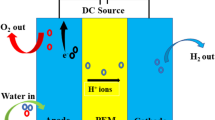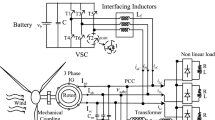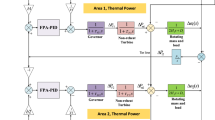Abstract
Providing access to clean, reliable, and affordable energy by adopting hybrid power systems is important for countries looking to achieve their sustainable development goals. This paper presents an optimization method for sizing a hybrid system including photovoltaic (PV), wind turbines with a hydroelectric pumped storage system. In this paper, the implementation of different optimization techniques has been investigated to achieve optimal sizing of grid-connected hybrid renewable energy systems. A comprehensive study has been carried out between Whale Optimization Algorithm (WOA), Water Cycle Algorithm (WCA), Salp Swarm Algorithm (SSA), and Grey Wolf optimizer (GWO) to validate each one. Moreover, the optimal sizing of the system’s components has been studied using real-time information and meteorological data of Ataka region located in Egypt. The purpose of the optimization process is to minimize the cost of energy from this hybrid system while satisfying the operation constraints including high reliability of the hybrid power supply, small fluctuation in the energy injected to the grid, and high utilization of the photovoltaic and wind complementary properties. MATLAB software package has been used to evaluate each optimization algorithm for solving the considered optimization problem. Simulation results proved that WOA has the most promising performance over other techniques.


















Similar content being viewed by others

References
Arabali A et al (2013) Stochastic performance assessment and sizing for a hybrid power system of solar/wind/energy storage. IEEE Trans Sustain Energy 5(2):363–371
Bagul AD et al (1996) Sizing of a stand-alone hybrid wind-photovoltaic system using a three-event probability density approximation. Sol Energy 56(4):323–335
Bernal-Agustín JL, Dufo-Lopez R (2009) Simulation and optimization of stand-alone hybrid renewable energy systems. Renew Sust Energ Rev 13(8):2111–2118
Bilal BO et al (2010) Optimal design of a hybrid solar–wind-battery system using the minimization of the annualized cost system and the minimization of the loss of power supply probability (LPSP). Renew Energy 35(10):2388–2390
Chen D, Ding K (2016) Chapter 4 - System stability and control technologies after large-scale wind power integration. In: Wang N, Kang C, Ren D (eds) Large-scale wind power grid integration. Academic Press, Oxford, pp 107–184
Diab AAZ, Rezk H (2019) Optimal sizing and placement of capacitors in radial distribution systems based on Grey Wolf, Dragonfly and Moth–Flame optimization algorithms. Iran J Sci Technol Trans Electr Eng 43(1):77–96
Diab AAZ et al (2019) Application of different optimization algorithms for optimal sizing of PV/wind/desiel/battery storage stand-alone hybrid microgrid. IEEE Access. https://doi.org/10.1109/ACCESS.2019.2936656
Egyptian Electricity Holding Company, M. o. E. a. E., Arab Republic of Egypt (2016) Annual Statistical Report 2015-2016
Ekren O, Ekren BY (2010) Size optimization of a PV/wind hybrid energy conversion system with battery storage using simulated annealing. Appl Energy 87(2):592–598
Elhadidy MA, Shaahid SM (2000) Parametric study of hybrid (wind+ solar+ diesel) power generating systems. Renew Energy 21(2):129–139
Eskandar H et al (2012) Water cycle algorithm–a novel metaheuristic optimization method for solving constrained engineering optimization problems. Comput Struct 110:151–166
Goedecke M et al (2007) Life cycle cost analysis of alternative vehicles and fuels in Thailand. Energy Policy 35(6):3236–3246
Grigsby LL (2016) Power system stability and control. CRC press
Haidar AMA et al (2011) Optimal configuration assessment of renewable energy in Malaysia. Renew Energy 36(2):881–888
IEA (2008) International Energy Agency
IEA (2012) Renewable energies for remote areas and islands
Junfeng L, Hu G et al (2009) Report on development of wind power in China 2008. China Environmental Science Press, Beijing
Kamwa I et al (2005) IEEE PSS2B versus PSS4B: the limits of performance of modern power system stabilizers. IEEE Trans Power Syst 20(2):903–915
Kaviani AK et al (2009) Optimal design of a reliable hydrogen-based stand-alone wind/PV generating system, considering component outages. Renew Energy 34(11):2380–2390
Kizilkan O, Dincer I (2015) Borehole thermal energy storage system for heating applications: Thermodynamic performance assessment. Energy Convers Manag 90:53–61
Kusakana K, Vermaak HJ (2013) Hybrid renewable power systems for mobile telephony base stations in developing countries. Renew Energy 51:419–425
Ma T et al (2014a) Feasibility study and economic analysis of pumped hydro storage and battery storage for a renewable energy powered island. Energy Convers Manag 79:387–397
Ma T et al (2014b) Technical feasibility study on a standalone hybrid solar-wind system with pumped hydro storage for a remote island in Hong Kong. Renew Energy 69:7–15
Ma T et al (2015a) Optimal design of an autonomous solar–wind-pumped storage power supply system. Appl Energy 160:728–736
Ma T et al (2015b) Pumped storage-based standalone photovoltaic power generation system: Modeling and techno-economic optimization. Appl Energy 137:649–659
Manolakos D et al (2001) A simulation-optimisation programme for designing hybrid energy systems for supplying electricity and fresh water through desalination to remote areas: case study: the Merssini village, Donoussa island, Aegean Sea, Greece. Energy 26(7):679–704
Marten AL, Newbold SC (2012) Estimating the social cost of non-CO 2 GHG emissions: methane and nitrous oxide. Energy Policy 51:957–972
Martin KE et al (2008) Exploring the IEEE standard C37. 118–2005 synchrophasors for power systems. IEEE Trans Power Deliv 23(4):1805–1811
Masadeh R et al (2018) Whale optimization algorithm for solving the maximum flow problem. EasyChair
Ministry of Electricity and Energy - Egypt, A. R. o. E (2019) Retrieved 5/7/2019, from www.moee.gov.eg
Mirjalili S, Lewis A (2016) The whale optimization algorithm. Adv Eng Softw 95:51–67
Mirjalili S et al (2014) Grey wolf optimizer. Adv Eng Softw 69:46–61
Mirjalili S et al (2017) Salp Swarm Algorithm: a bio-inspired optimizer for engineering design problems. Adv Eng Softw 114:163–191
Mohamed MA et al (2019a) A novel adaptive model predictive controller for load frequency control of power systems integrated with DFIG wind turbines. Neural Comput Appl:1–11
Mohamed MA et al (2019b) A novel framework-based cuckoo search algorithm for sizing and optimization of grid-independent hybrid renewable energy systems. Int J Green Energy 16(1):86–100
Mortensen NG et al (n.d.) Wind atlas for Egypt: measurements, micro-and mesoscale modelling. European Wind Energy Association (EWEA)
Ngan MS, Tan CW (2012) Assessment of economic viability for PV/wind/diesel hybrid energy system in southern Peninsular Malaysia. Renew Sust Energ Rev 16(1):634–647
Niknam T et al (2012) Distribution feeder reconfiguration considering fuel cell/wind/photovoltaic power plants. Renew Energy 37(1):213–225
Pal MK (1992) Voltage stability conditions considering load characteristics. IEEE Trans Power Syst 7(1):243–249
Ramli MAM et al (2018) Optimal sizing of PV/wind/diesel hybrid microgrid system using multi-objective self-adaptive differential evolution algorithm. Renew Energy 121:400–411
Sadollah A et al (2015) Water cycle algorithm for solving multi-objective optimization problems. Soft Comput 19(9):2587–2603
Spyrou ID, Anagnostopoulos JS (2010) Design study of a stand-alone desalination system powered by renewable energy sources and a pumped storage unit. Desalination 257(1-3):137–149
Sultan HM et al (2018) Design and evaluation of PV-wind hybrid system with hydroelectric pumped storage on the National Power System of Egypt. Glob Energy Interconnection 1(3):301–311
United States Energy Information Administration (EIA) (2015) Quarterly coal report (Abbreviated). Retrieved 25/8/2019 from http://www.eia.gov/coal/production/quarterly/pdf/0121152q.pdf
United States Environmental Protection Agency (EPA) (2019) The social cost of carbon. Retrieved 25/8/2019 from https://www3.epa.gov/climatechange/EPAactivities/economics/scc.html
Vijay R, Sowmya R (2017) Optimal sitting of PV-wind-energy storage system integrated micro grid using artificial bee colony optimization technique. Int J Innov Res Comput Commun Eng 80
Wolpert DH, Macready WG (1997) No free lunch theorems for optimization. IEEE Trans Evol Comput 1(1):67–82
Xu L et al (2013) An improved optimal sizing method for wind-solar-battery hybrid power system. IEEE Trans Sustain Energy 4(3):774–785
Zhang J et al (2018) Parameter estimation for soil water retention curve using the salp swarm algorithm. Water 10(6):815
Author information
Authors and Affiliations
Corresponding author
Ethics declarations
Conflict of interest
The authors declare that they have no conflict of interest.
Additional information
Responsible editor: Philippe Garrigues
Publisher’s note
Springer Nature remains neutral with regard to jurisdictional claims in published maps and institutional affiliations.
Rights and permissions
About this article
Cite this article
Diab, A.A.Z., Sultan, H.M. & Kuznetsov, O.N. Optimal sizing of hybrid solar/wind/hydroelectric pumped storage energy system in Egypt based on different meta-heuristic techniques. Environ Sci Pollut Res 27, 32318–32340 (2020). https://doi.org/10.1007/s11356-019-06566-0
Received:
Accepted:
Published:
Issue Date:
DOI: https://doi.org/10.1007/s11356-019-06566-0



